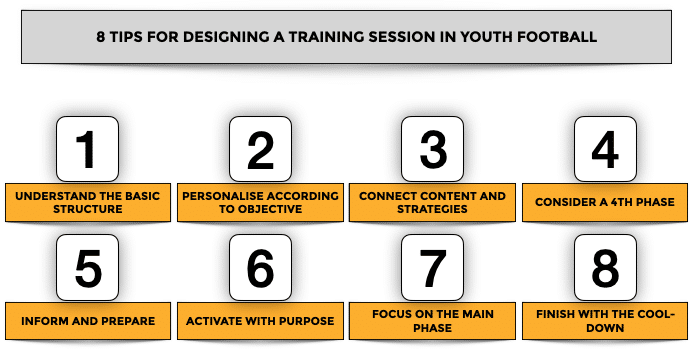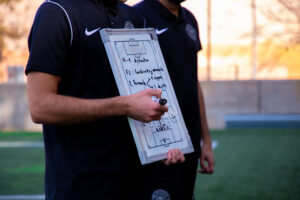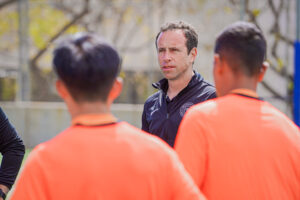Designing a training session in youth football is crucial for the overall development of players. The key to success on the pitch lies not only in technical execution, but also in the strategic planning of each training session.
Below, we explore the 8 fundamental tips for the design of a training session in youth football.
1.- Understand the Basic Structure
Understanding the basic structure of a training session is key. Authors such as Bompa (2007) and Vasconcelos (2005) suggest dividing it into three parts during the adaptation and initiation stages of football: warm-up, main part and cool-down. This facilitates the progression in the increase and reduction of loads during practice.
2.- Personalise according to Objectives:
The session should be adapted to the specific objectives of the team. The structure should be balanced with exercises organised in means and methods, aligned with the predefined objectives. Adjust the structure according to the needs of your group.
3.- Connect Content and Strategies:
The relationship between content and didactic strategies is essential. Organise the session into parts to address specific blocks of content. This allows for a coherent interrelationship between the focus areas, maximising learning during practice.
4.- Consider a 4th phase:
Some experts, such as Mirallas (1995), suggest a four-part structure when the football player enters the technification period, dividing the main part into initial development and final development. This allows for more specific attention to technical and tactical learning and improvement.
5.- Inform and Prepare:
The information phase is crucial. Before the start, inform the players about the tasks, content and objectives. This will allow the group to be aware of the objectives to be achieved, preparing the team mentally.
6.- Activate with Purpose:
The activation phase is not simply a physical warm-up. It is related to the work on coordination, perceptual and space management skills, especially in the initiation period. We also need to increase the activity of the cognitive, coordination and psychological systems.
7.- Focus on the Main Phase:
The main phase is where the central objectives are developed. Coaches such as Vasconcelos (2005) emphasise the selection of exercises aligned with the objectives. Prioritise tactical concepts and ensure that players understand and assimilate the fundamentals of the game.
8.- Finish with the Cool-Down:
The cool-down phase is more than a gradual reduction of the load. In this part of the session, games and low-intensity tasks can be used to normalise the body’s functions. At the end of the session, a common reflection on the trained content is done to reinforce learning.
Source: MBP School of Coaches
Conclusion
Putting together a good training session in football involves understanding the structure, customising according to objectives, connecting content and strategies, considering a fourth phase, informing and preparing, activating with purpose, focusing on the main phase and ending with meaningful reflection. These tips form the basis for effective and sustainable development on the pitch.








